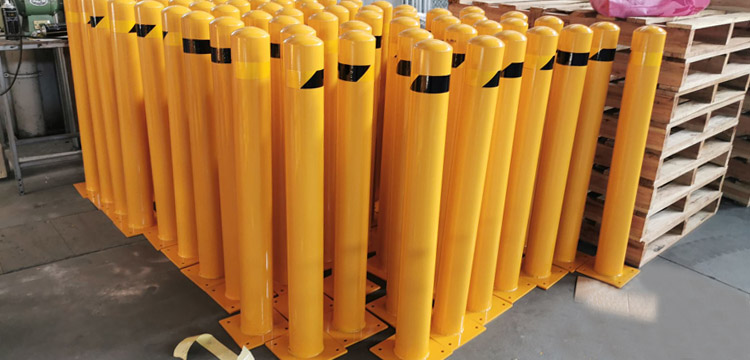Steel Crash Protection Bollards
What are steel bollards?
Steel bollards are a type of metal bollards with powder coating finish or painting finish or hot galvanized finish to protect buildings, infrastructure, pedestrians, machines pillars, supports, columns, (roller) gates, loading ramps etc. in urban and industrial environments.
What are steel bollards called?
Steel bollards are also called steel pipe bollards, security bollards, safety bollards, steel safety bollards, crash protection bollards, parking bollards, parking pipe bollards, crash rated bollards, impact related bollards, steel crash protection bollards, crash protection guards, crash protection bars and crash protection barriers.
What’s the material of steel bollards?
The material is Q235, carbon steel.
What the sizes of steel bollards?
Below are the conventional sizes that we produce, and we can also make ODM and OEM.

How many types of steel bollards?
Usually there are two types, inground bollards and surface mounted bollards.
Why are steel bollards important?
Steel bollards are often called crash protection bollards, here are the reasons why it is so important in urban and industrial environments below:
Vehicle Impact Mitigation. Steel bollards are designed to withstand the impact of vehicles and stop vehicles entering restricted areas, pedestrian zones, or buildings, similar to 304 stainless steel pipe bollards, but 304 SS pipe bollards are more impact resistance.
Building, Infrastructure and Equipment Protection. Bollards installed around buildings, storefronts, critical infrastructure or equipment prevent them from accidental collisions or viciously ramming attacks.
Pedestrian Safety. Steel bollards not only separate walkways from vehicle lanes, controlling traffic flow, but also improve the pedestrian safety from crashing due to impact resistance.
Traffic Control and Security. Steel bollards can be used as a road divider like reflective galvanized posts to manager traffic flow, and more importantly, they could take responsibility to bear the crashing, force it to stop in accident-prone locations and reduce the damage to the least.
Impact or Crashing Protection. Steel bollards usually are installed in toll station, logistics warehousing, logistics transfer center or port terminal to protect them from impacting or crashing and create relatively safe areas for workers and goods.
What are the advantages of steel bollards?
Steel bollards offer several advantages due to their material properties and design. Here are some of the key advantages of using steel bollards,
Resistance to Impact. Steel is a robust and durable material, making steel bollards highly resistant to impacts and wear. They can withstand collisions from vehicles, harsh weather conditions, and general wear and tear, providing long-lasting protection.
Resistance to Rust. Steel bollard itself is not resistance to rust, but with powder coated or painting or hot galvanized, it can be resistance to rust and could stay outdoor for a very long time even if in villainous weather.
Fair price. The price is cheaper than 304 stainless steel pipe bollards, but the function is similar.
Versatility. Steel bollards come in various shapes, sizes, and designs, allowing them to be used for a wide range of applications. They can serve as decorative elements in urban landscapes or be installed for specific traffic control and safety purposes.
Reflective Tape. Steel bollards usually are pasted 5mm reflective tape on top, then it could be reflected in night to warning the vehicles coming.
Compliance with Safety Standards. Steel bollards are manufactured to meet specific safety standards, ensuring they provide the required level of protection and meet local regulations.
Come to conclusion, steel bollards, also called impact related bollards or crash protection bollards are a type of economical and practical, resistance to impact and rust, compliance with safety standards’ metal bollards and plays a crucial roles in safeguarding pedestrians, vehicles, buildings, infrastructures, equipment and traffic control and security, these which making them more and more important in the future in various public and private spaces, please contact us [email protected] if you have some interest.





Leave a Reply
Want to join the discussion?Feel free to contribute!